|
|

This chapter describes the CiscoWorks Blue Maps Advanced Peer-to-Peer Networking (APPN) application. It contains the following major sections:
If you prefer to view the APPN information from a web browser, see the chapter "Using the Web Browser."
The APPN application displays a global map of the APPN network topology. The global map is made up of the APPN network nodes (NNs) and the transmission groups (TGs) between them. The network nodes and the transmission groups make up the backbone of the APPN network. From the global map, you can display more detailed maps that show the APPN end nodes (ENs) and low-entry network nodes (LENs) along with the network nodes and the transmission groups.
All APPN network nodes store the same information about the backbone APPN network. At startup, the APPN application must access the network information that is stored in any one APPN network node. APPN needs the information from the APPN Management Information Base (MIB) before it can display an APPN map. The network node that supplies this network information is called the network topology agent.
APPN network nodes are named in the format NETID.CPNAME, rather than by IP address or device name. For example, a node with NETID=NETA and CPNAME=IBUPU3 would be displayed as NETA.IBUPU3.
However, the APPN application needs IP addresses or device names so that it can manage the APPN routers using SNMP. APPN uses its discovery process to correlate the APPN names with the IP addresses or device names.
You can start the APPN application from the workstation system prompt, from a remote workstation, or from a network management system, such as NetView for AIX.
You can start APPN in one of the following ways:
You can start APPN from any valid user account. The installation process establishes a sample default user account named cwblue. The user cwblue does not have a starting password. The user cwblue does not have a starting password. You can either assign a password to cwblue or log in as root and change to cwblue.
To start the APPN Maps application from a workstation system prompt, enter these commands:
cd /opt/CSCOcb/bin
./cwb start appn [-f devicename [-r read_community_string]] [-v] [-h]
Where:
-f devicename specifies the host name or IP address of an APPN node to be used as the network topology agent.
-r read_community_string specifies the read community string for the router specified by devicename. APPN uses the read_community_string value when communicating with an APPN node. If you do not enter a read community string, the APPN application uses the default read community string specified in the cwbinit file or, if there is not one there, the default string "public."
-v displays version information.
-h displays online help.
You can log in to a remote UNIX host from your own local UNIX workstation, export the remote host display to your local workstation, and then run the application from the remote host. To start the remote host's APPN application from your local workstation, use the following procedure:
Step 1 At your local UNIX workstation, enter the following command:
xhost +
Step 2 Log in to the remote UNIX host.
Step 3 Set your DISPLAY environment variable to export the display from the remote host to your local workstation. Depending on which shell you are using, use one of these commands:
setenv DISPLAY
export DISPLAY=IP_address:0.0
setenv DISPLAY IP_address:0.0
Step 4 To start APPN, enter the following commands:
cd /opt/CSCOcb/bin
./cwb start appn [-f devicename [-r read_community_string]] [-v]
Where:
-f devicename specifies the host name or IP address of an APPN node to be used as the network topology agent. APPN displays a global view at startup. For the name of a network topology agent, see your network administrator.
-r read_community_string specifies the read community string for the router specified by devicename. APPN uses the read_community_string value when communicating with APPN nodes. If you do not enter this value, the program uses the default read community string "public," unless another default string is specified in the cwbinit file.
-v displays version information.
To start APPN from a network management system:
If you start APPN from NetView, or if you do not enter any options with the cwb start appn command, the APPN application looks in its preferences file, $CWBROOT/etc/cwbinit, for the control point (CP) name, or for an IP address or device name (and read community string) of a network topology agent. If a network topology agent is not specified in the cwbinit file, APPN displays the APPN Startup Query window, shown in Figure 6-1, which prompts you to identify a network topology agent.

This section describes how to locate and select nodes on the APPN map.
There are two methods for locating a node on the APPN map:
To locate a node from the View menu you must know the node's CP name, IP address, or host name. Then use the following procedure:
Step 1 Select View>Locate from the APPN menu bar.
Step 2 Select either By CP Name or By IP Address or Device Name.
Step 3 Enter the CP name, IP address, or host name of an APPN node.
Step 4 Click Locate.
APPN displays the portion of the map that contains the selected device and highlights the device.
Each icon on the APPN map has an associated popup menu. To activate the menu, click the icon with the right mouse button. Table 6-1 lists the popup menus associated with the APPN map icons.
| Icon | Popup Menu Items |
|---|---|
Information---Displays information about the selected node, including the device type, the node type, and the node's capability information. List LUs---Lists the LUs associated with the selected node.
Get Directory---Queries the selected node to compile a directory of LUs. Show Adjacent Nodes---Displays the nodes adjacent to the selected node. Telnet---Starts a Telnet client. | |
Port Info---Displays information about the selected port, including the port name and status, the data-link control type, and the MAC and SAP addresses. | |
Link | Link Info---Displays information about the selected link, including the link name, CP names at either end of the link, link addresses, and link capacities. |
Virtual routing node | Information---Displays information about the selected node, including the device and node types, and capability information. Show Adjacent Nodes---Displays the nodes adjacent to the selected node. Telnet---Starts a Telnet client. |
The APPN map presents a global (high-level) view of the applicable network devices and an up-to-date view of the APPN-enabled network nodes and their status and the transmission groups that connect them. From the APPN menu bar, select View to display the available views of the network map. You can display the following views:
The global view is displayed when you start the APPN application. To display the global view at another time, select View>Global from the APPN menu bar. The global view is displayed, as shown in Figure 6-2.
The global view displays devices and connections from the APPN network topology database as viewed from the network topology agent. The global view shows the network nodes and virtual routing nodes and the transmission groups (TGs) between them. The TGs are aggregated so that one line between two nodes represents one or more TGs between the nodes.
If a node has unknown status, APPN has determined that the network topology agent is not getting updates about that node. This problem may be caused by inactive TGs or no CP-CP sessions to carry the updates.
The global view is updated as new information is available from the network topology agent, subject to the polling interval (defined by the nettopopoll parameter in the cwbinit file).
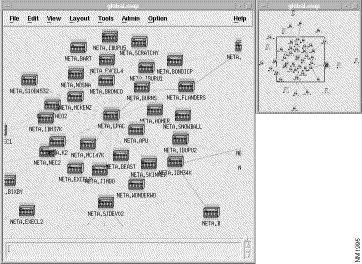
To view information about the connections between the nodes, use the following procedure from the global view (Figure 6-2):
Step 1 From the APPN global view, point to a TG (the line that connects the two nodes).
Step 2 Press the right mouse button.
Step 3 Select one of the following items from the popup menu:
Step 4 Select Info from the popup menu to display details about the TG or link that you selected.
To view network node information, use the following procedure:
Step 1 Point to a node.
Step 2 Press the right mouse button.
Step 3 Select Information.
APPN displays information about that node, including its CP name, device type, and node type, as shown in Figure 6-3.
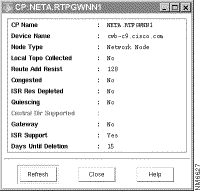
To view the supported LUs, you must first collect directory information from the network. Use the following procedure to collect directory information and display LUs.
Step 1 Select a network node.
Step 2 Press the right mouse button.
Step 3 Select Get Directory from the popup menu.
Step 4 Press the right mouse button again.
Step 5 Select List LUs from the popup menu. The List LUs window displays a list of LU names that are supported by the selected network node. For each LU in the list, APPN displays the control point where the LU resides, the network node server, and the LU's directory type.
To view adjacent nodes, use the following procedure:
Step 1 From the APPN global view, point to a node.
Step 2 Press the right mouse button.
Step 3 Select Show Adjacent Nodes.
The adjacent nodes view shows a subset of the APPN network that includes the following nodes:
To view the ports and links information, use the following procedure:
Step 1 Point to a node.
Step 2 Press the right mouse button.
Step 3 Select Ports and Links.
The ports and links view, shown in Figure 6-4, is a view of all the logical ports on the selected node and the links from those ports to adjacent nodes. Each adjacent node is displayed with its network ID (NETID) and control point name (CPNAME) in the format NETID.CPNAME.

If there is an inactive link and the node does not have the adjacent CP name defined, APPN displays the node with the text "link=linkname" in place of the node's APPN name, as shown in Figure 6-5.

This label indicates that the link is inactive and the destination node of the link is not known to the selected APPN node.
The quotation mark (?) indicates that the node's name is also not known. The text "link=linkname" indicates the link between the known APPN node and the unknown node.
The ports and links view can depict the following port types:
To display detailed information about a port on a network node, use the following procedure:
Step 1 From the ports and links view, select a port icon.
Step 2 Press the right mouse button.
Step 3 Select Port Info.
The APPN application displays the port information window, shown in Figure 6-6, which includes the port name, port state, data-link control (DLC) type, and line type.
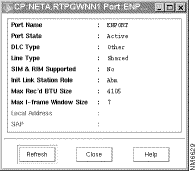
To display detailed information about link, use the following procedure:
Step 1 From the ports and links view, select a link icon.
Step 2 Press the right mouse button.
Step 3 Select Link Info.
The APPN application displays the Link Information window, as shown in Figure 6-7.
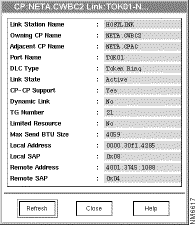
This section describes how to use the Tools menu to view PUs and LUs in the APPN network. APPN collects the PU information from the DLUR MIB on the router, and it collects LU information from the directory table in the APPN MIB.
You can select Tools>PU from the menu bar to configure filtering criteria for use in searching the database for PUs. To locate PUs from the Tools menu, use the following procedure:
Step 1 From the Map application's menu bar, select Tools>PU. The PU Filter window is displayed (Figure 6-8).
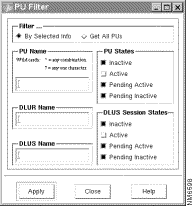
Step 2 In the PU Filter window, select one of the following methods for filtering the PU names:
Step 3 Click Apply. The PU List window is displayed, showing the PU names, filtered as you requested. The PU List window (Figure 6-9).

The PU List window displays the DLUR name, the DLUS name, and the DLUR-DLUS session state for each PU.
When you select Tools>PU from the menu bar, the APPN application displays the PU Filter window to let you configure a filter for use in selecting the PUs to display. You can get all PUs, or you can configure the filter to select PUs based on applied criteria. You can filter the names in the PU List based on the PU name, DLUR name, DLUS name, PU state, and DLUR-DLUS session state.
To display all PUs, select Get All PUs to display a PU List that contains all PU names in the network.
To display PUs based on their PU names, enter all or part of a PU name in the form NAME. You can use a wildcard, such as PU*, to display a list of PU names that all begin with the same characters. The PU List will contain PUs whose PU names match the filter criteria.
To display PUs based on the DLUR name, enter all or part of a DLUR name. You can also use wildcards in this name. The PU List will contain PUs whose DLUR names satisfy the filter criteria.
To display PUs based on the DLUS name, enter all or part of a DLUS name. You can also use wildcards in this name. The PU List will contain PUs whose DLUS names satisfy the filter criteria.
To display PUs based on their PU state, select one or more PU states. The PU List window will contain the names of PUs that match one of the selected PU states. The possible PU states are Inactive, Active, Pending Active, and Pending Inactive.
To display all PUs based on the DLUR-DLUS session state, select one or more DLUS session states. The DLUS session state indicates the status of the CPSVRMGR control session between the DLUR node and the DLUS node. The PU List window will contain the names of PUs that match one of the selected DLUR-DLUS session states. The possible DLUR-DLUS session states are Inactive, Active, Pending Active, and Pending Inactive.
To display a list of all LUs, select Tools>LU from the menu bar. The LU List window is displayed (Figure 6-10).

The LU List window displays a row of information for each independent or dependent LU. Each row contains the following items:
The colors and symbols on the APPN map have the following meanings:
Table 6-2 identifies the icons displayed on an APPN map.
| Icon | Description |
|---|---|
| Known APPN network node. |
| Managed APPN network node; the check mark above the icon shows that the NN is managed by CiscoWorks Blue Maps. |
| APPN network topology agent in a global view. Focus node in an adjacent node or ports and links view. |
| APPN end node. |
| APPN LEN node.
|
| Port on an APPN network node. The letter in the circle indicates the port type:
|
| Unknown or unmanaged node. |
| Host node (VTAM mainframe). |
| Virtual routing node (connection network). |
![]()
![]()
![]()
![]()
![]()
![]()
![]()
![]()
Posted: Wed Jun 30 06:25:35 PDT 1999
Copyright 1989-1999©Cisco Systems Inc.